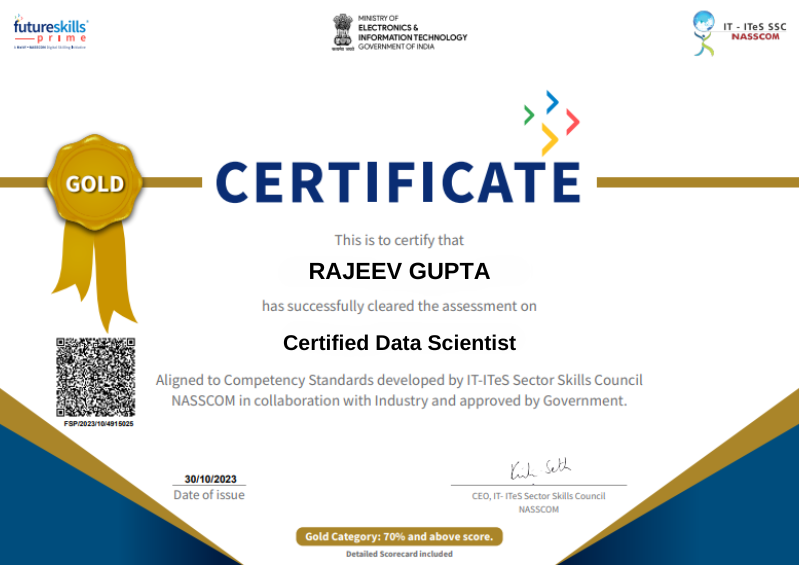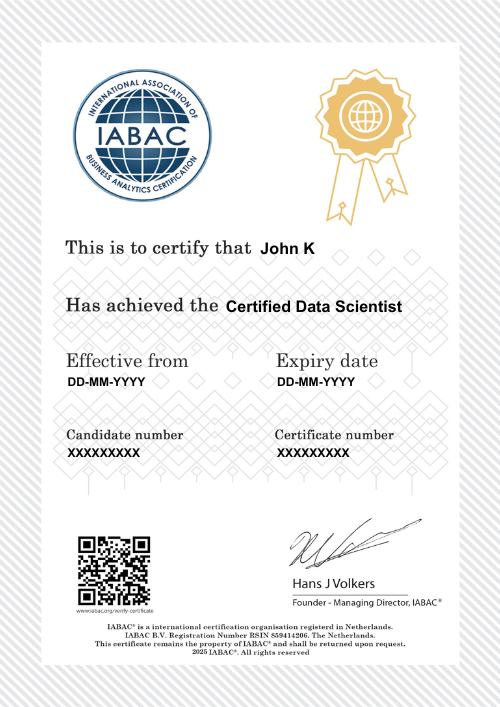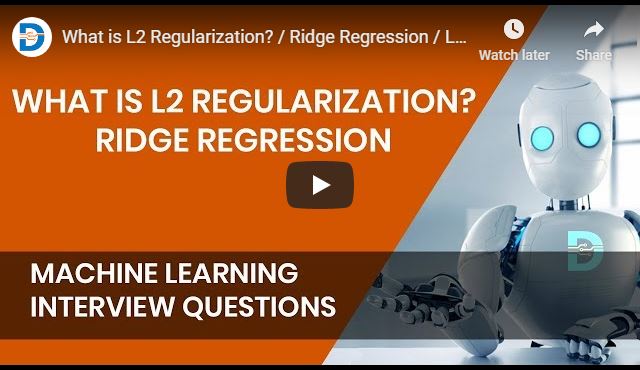Instructor Led Live Online
Self Learning + Live Mentoring
Customize Your Training


MODULE 1: DATA SCIENCE ESSENTIALS
• Introduction to Data Science
• Evolution of Data Science
• Big Data Vs Data Science
• Data Science Terminologies
• Data Science vs AI/Machine Learning
• Data Science vs Analytics
MODULE 2: DATA SCIENCE DEMO
• Business Requirement: Use Case
• Data Preparation
• Machine learning Model building
• Prediction with ML model
• Delivering Business Value.
MODULE 3: ANALYTICS CLASSIFICATION
• Types of Analytics
• Descriptive Analytics
• Diagnostic Analytics
• Predictive Analytics
• Prescriptive Analytics
• EDA and insight gathering demo in Tableau
MODULE 4: DATA SCIENCE AND RELATED FIELDS
• Introduction to AI
• Introduction to Computer Vision
• Introduction to Natural Language Processing
• Introduction to Reinforcement Learning
• Introduction to GAN
• Introduction to Generative Passive Models
MODULE 5: DATA SCIENCE ROLES & WORKFLOW
• Data Science Project workflow
• Roles: Data Engineer, Data Scientist, ML Engineer and MLOps Engineer
• Data Science Project stages.
MODULE 6: MACHINE LEARNING INTRODUCTION
• What Is ML? ML Vs AI
• ML Workflow, Popular ML Algorithms
• Clustering, Classification And Regression
• Supervised Vs Unsupervised
MODULE 7: DATA SCIENCE INDUSTRY APPLICATIONS
• Data Science in Finance and Banking
• Data Science in Retail
• Data Science in Health Care
• Data Science in Logistics and Supply Chain
• Data Science in Technology Industry
• Data Science in Manufacturing
• Data Science in Agriculture
MODULE 1: PYTHON BASICS
• Introduction of python
• Installation of Python and IDE
• Python Variables
• Python basic data types
• Number & Booleans, strings
• Arithmetic Operators
• Comparison Operators
• Assignment Operators
MODULE 2: PYTHON CONTROL STATEMENTS
• IF Conditional statement
• IF-ELSE
• NESTED IF
• Python Loops basics
• WHILE Statement
• FOR statements
• BREAK and CONTINUE statements
MODULE 3: PYTHON DATA STRUCTURES
• Basic data structure in python
• Basics of List
• List: Object, methods
• Tuple: Object, methods
• Sets: Object, methods
• Dictionary: Object, methods
MODULE 4: PYTHON FUNCTIONS
• Functions basics
• Function Parameter passing
• Lambda functions
• Map, reduce, filter functions
MODULE 1: OVERVIEW OF STATISTICS
• Introduction to Statistics
• Descriptive And Inferential Statistics
• Basic Terms Of Statistics
• Types Of Data
MODULE 2: HARNESSING DATA
• Random Sampling
• Sampling With Replacement And Without Replacement
• Cochran's Minimum Sample Size
• Types of Sampling
• Simple Random Sampling
• Stratified Random Sampling
• Cluster Random Sampling
• Systematic Random Sampling
• Multi stage Sampling
• Sampling Error
• Methods Of Collecting Data
MODULE 3: EXPLORATORY DATA ANALYSIS
• Exploratory Data Analysis Introduction
• Measures Of Central Tendencies: Mean,Median And Mode
• Measures Of Central Tendencies: Range, Variance And Standard Deviation
• Data Distribution Plot: Histogram
• Normal Distribution & Properties
• Z Value / Standard Value
• Empirical Rule and Outliers
• Central Limit Theorem
• Normality Testing
• Skewness & Kurtosis
• Measures Of Distance: Euclidean, Manhattan And Minkowski Distance
• Covariance & Correlation
MODULE 4: HYPOTHESIS TESTING
• Hypothesis Testing Introduction
• P- Value, Critical Region
• Types of Hypothesis Testing
• Hypothesis Testing Errors : Type I And Type II
• Two Sample Independent T-test
• Two Sample Relation T-test
• One Way Anova Test
• Application of Hypothesis testing
MODULE 1: MACHINE LEARNING INTRODUCTION
• What Is ML? ML Vs AI
• Clustering, Classification And Regression
• Supervised Vs Unsupervised
MODULE 2: PYTHON NUMPY PACKAGE
• Introduction to Numpy Package
• Array as Data Structure
• Core Numpy functions
• Matrix Operations, Broadcasting in Arrays
MODULE 3: PYTHON PANDAS PACKAGE
• Introduction to Pandas package
• Series in Pandas
• Data Frame in Pandas
• File Reading in Pandas
• Data munging with Pandas
MODULE 4: VISUALIZATION WITH PYTHON - Matplotlib
• Visualization Packages (Matplotlib)
• Components Of A Plot, Sub-Plots
• Basic Plots: Line, Bar, Pie, Scatter
MODULE 5: PYTHON VISUALIZATION PACKAGE - SEABORN
• Seaborn: Basic Plot
• Advanced Python Data Visualizations
MODULE 6: ML ALGO: LINEAR REGRESSSION
• Introduction to Linear Regression
• How it works: Regression and Best Fit Line
• Modeling and Evaluation in Python
MODULE 7: ML ALGO: LOGISTIC REGRESSION
• Introduction to Logistic Regression
• How it works: Classification & Sigmoid Curve
• Modeling and Evaluation in Python
MODULE 8: ML ALGO: K MEANS CLUSTERING
• Understanding Clustering (Unsupervised)
• K Means Algorithm
• How it works : K Means theory
• Modeling in Python
MODULE 9: ML ALGO: KNN
• Introduction to KNN
• How It Works: Nearest Neighbor Concept
• Modeling and Evaluation in Python
MODULE 1: FEATURE ENGINEERING
• Introduction to Feature Engineering
• Feature Engineering Techniques: Encoding, Scaling, Data Transformation
• Handling Missing values, handling outliers
• Creation of Pipeline
• Use case for feature engineering
MODULE 2: ML ALGO: SUPPORT VECTOR MACHINE (SVM)
• Introduction to SVM
• How It Works: SVM Concept, Kernel Trick
• Modeling and Evaluation of SVM in Python
MODULE 3: PRINCIPAL COMPONENT ANALYSIS (PCA)
• Building Blocks Of PCA
• How it works: Finding Principal Components
• Modeling PCA in Python
MODULE 4: ML ALGO: DECISION TREE
• Introduction to Decision Tree & Random Forest
• How it works
• Modeling and Evaluation in Python
MODULE 5: ENSEMBLE TECHNIQUES - BAGGING
• Introduction to Ensemble technique
• Bagging and How it works
• Modeling and Evaluation in Python
MODULE 6: ML ALGO: NAÏVE BAYES
• Introduction to Naive Bayes
• How it works: Bayes' Theorem
• Naive Bayes For Text Classification
• Modeling and Evaluation in Python
MODULE 7: GRADIENT BOOSTING, XGBOOST
• Introduction to Boosting and XGBoost
• How it works?
• Modeling and Evaluation of in Python
MODULE 1: TIME SERIES FORECASTING - ARIMA
• What is Time Series?
• Trend, Seasonality, cyclical and random
• Stationarity of Time Series
• Autoregressive Model (AR)
• Moving Average Model (MA)
• ARIMA Model
• Autocorrelation and AIC
• Time Series Analysis in Python
MODULE 2: SENTIMENT ANALYSIS
• Introduction to Sentiment Analysis
• NLTK Package
• Case study: Sentiment Analysis on Movie Reviews
MODULE 3: REGULAR EXPRESSIONS WITH PYTHON
• Regex Introduction
• Regex codes
• Text extraction with Python Regex
MODULE 4: ML MODEL DEPLOYMENT WITH FLASK
• Introduction to Flask
• URL and App routing
• Flask application – ML Model deployment
MODULE 5: ADVANCED DATA ANALYSIS WITH MS EXCEL
• MS Excel core Functions
• Advanced Functions (VLOOKUP, INDIRECT..)
• Linear Regression with EXCEL
• Data Table
• Goal Seek Analysis
• Pivot Table
• Solving Data Equation with EXCEL
MODULE 6: AWS CLOUD FOR DATA SCIENCE
• Introduction of cloud
• Difference between GCC, Azure, AWS
• AWS Service ( EC2 instance)
MODULE 7: AZURE FOR DATA SCIENCE
• Introduction to AZURE ML studio
• Data Pipeline
• ML modeling with Azure
MODULE 8: INTRODUCTION TO DEEP LEARNING
• Introduction to Artificial Neural Network, Architecture
• Artificial Neural Network in Python
• Introduction to Convolutional Neural Network, Architecture
• Convolutional Neural Network in Python
MODULE 1: DATABASE INTRODUCTION
• DATABASE Overview
• Key concepts of database management
• Relational Database Management System
• CRUD operations
MODULE 2: SQL BASICS
• Introduction to Databases
• Introduction to SQL
• SQL Commands
• MY SQL workbench installation
MODULE 3: DATA TYPES AND CONSTRAINTS
• Numeric, Character, date time data type
• Primary key, Foreign key, Not null
• Unique, Check, default, Auto increment
MODULE 4: DATABASES AND TABLES (MySQL)
• Create database
• Delete database
• Show and use databases
• Create table, Rename table
• Delete table, Delete table records
• Create new table from existing data types
• Insert into, Update records
• Alter table
MODULE 5: SQL JOINS
• Inner Join, Outer Join
• Left Join, Right Join
• Self Join, Cross join
• Windows function: Over, Partition, Rank
MODULE 6: SQL COMMANDS AND CLAUSES
• Select, Select distinct
• Aliases, Where clause
• Relational operators, Logical
• Between, Order by, In
• Like, Limit, null/not null, group by
• Having, Sub queries
MODULE 7 : DOCUMENT DB/NO-SQL DB
• Introduction of Document DB
• Document DB vs SQL DB
• Popular Document DBs
• MongoDB basics
• Data format and Key methods
MODULE 1: GIT INTRODUCTION
• Purpose of Version Control
• Popular Version control tools
• Git Distribution Version Control
• Terminologies
• Git Workflow
• Git Architecture
MODULE 2: GIT REPOSITORY and GitHub
• Git Repo Introduction
• Create New Repo with Init command
• Git Essentials: Copy & User Setup
• Mastering Git and GitHub
MODULE 3: COMMITS, PULL, FETCH AND PUSH
• Code Commits
• Pull, Fetch and Conflicts resolution
• Pushing to Remote Repo
MODULE 4: TAGGING, BRANCHING AND MERGING
• Organize code with branches
• Checkout branch
• Merge branches
• Editing Commits
• Commit command Amend flag
• Git reset and revert
MODULE 5: GIT WITH GITHUB AND BITBUCKET
• Creating GitHub Account
• Local and Remote Repo
• Collaborating with other developers
MODULE 1: BIG DATA INTRODUCTION
• Big Data Overview
• Five Vs of Big Data
• What is Big Data and Hadoop
• Introduction to Hadoop
• Components of Hadoop Ecosystem
• Big Data Analytics Introduction
MODULE 2 : HDFS AND MAP REDUCE
• HDFS – Big Data Storage
• Distributed Processing with Map Reduce
• Mapping and reducing stages concepts
• Key Terms: Output Format, Partitioners,
• Combiners, Shuffle, and Sort
MODULE 3: PYSPARK FOUNDATION
• PySpark Introduction
• Spark Configuration
• Resilient distributed datasets (RDD)
• Working with RDDs in PySpark
• Aggregating Data with Pair RDDs
MODULE 4: SPARK SQL and HADOOP HIVE
• Introducing Spark SQL
• Spark SQL vs Hadoop Hive
MODULE 1: TABLEAU FUNDAMENTALS
• Introduction to Business Intelligence & Introduction to Tableau
• Interface Tour, Data visualization: Pie chart, Column chart, Bar chart.
• Bar chart, Tree Map, Line Chart
• Area chart, Combination Charts, Map
• Dashboards creation, Quick Filters
• Create Table Calculations
• Create Calculated Fields
• Create Custom Hierarchies
MODULE 2: POWER-BI BASICS
• Power BI Introduction
• Basics Visualizations
• Dashboard Creation
• Basic Data Cleaning
• Basic DAX FUNCTION
MODULE 3 : DATA TRANSFORMATION TECHNIQUES
• Exploring Query Editor
• Data Cleansing and Manipulation:
• Creating Our Initial Project File
• Connecting to Our Data Source
• Editing Rows
• Changing Data Types
• Replacing Values
MODULE 4: CONNECTING TO VARIOUS DATA SOURCES
• Connecting to a CSV File
• Connecting to a Webpage
• Extracting Characters
• Splitting and Merging Columns
• Creating Conditional Columns
• Creating Columns from Examples
• Create Data Model
The Data Science landscape spans machine learning, statistics, and data analysis, converging to derive insights crucial for well-informed decision-making.
The intersection of Big Data and Data Science lies in managing and analyzing extensive datasets, with Big Data emphasizing tools tailored for handling voluminous data.
While coding is beneficial, those without coding experience can enter Data Science through no-code/low-code platforms.
Educational qualifications often include a bachelor's or master's degree in fields like computer science, statistics, or mathematics.
Aspiring Data Scientists should possess programming skills (e.g., Python), statistical knowledge, machine learning expertise, data visualization skills, and strong problem-solving abilities.
Building an impactful portfolio involves showcasing real-world projects, emphasizing problem-solving skills, and demonstrating proficiency in relevant tools and techniques.
Proficiency in Python is often considered vital for Data Science roles due to its prevalence in data analysis, machine learning, and building data pipelines.
The standard career path in Belgium may include roles such as Data Analyst, Junior Data Scientist, Senior Data Scientist, with potential progression to managerial positions.
Enrollment is generally open to individuals with a background in mathematics, statistics, computer science, or related fields.
Initial steps include gaining foundational knowledge, acquiring relevant technical skills, and networking with local professionals and organizations.
Belgium Compensation for Data Scientists in Belgium varies based on experience, skills, and industry, with an average annual salary range of EUR 45,140.
Belgium Crafting an impactful portfolio involves showcasing diverse projects, emphasizing technical skills, and providing clear explanations of methodologies and outcomes.
Belgium's Demand for Data Scientists is notably high in tech hubs like Silicon Valley, financial centers, and the healthcare sector on a global scale.
Belgium Current trends include explainable AI, automated machine learning, and an increased emphasis on ethical considerations within AI applications.
Belgium A postgraduate degree is not always a requirement; many programs in Belgium accept candidates based on relevant experience and skills.
Belgium The Data Science workflow encompasses data collection, cleaning, exploration, modeling, validation, and deployment, with iterative steps for continuous improvement.
Belgium Data Science in Belgium enhances business growth through improved decision-making, customer insights, and optimized operations, thereby increasing competitiveness.
Belgium The Certified Data Scientist Course is a top-tier option for data science training in Belgium, covering crucial topics like machine learning and data analysis.
Belgium Data Science finds applications in industries such as finance, healthcare, e-commerce, and telecommunications, contributing to predictive analytics, fraud detection, and personalized marketing.
Belgium Data Science focuses on extracting insights from data, while Machine Learning, as a subset, involves training models to make predictions or decisions based on data.
The DataMites Certified Data Scientist Course in Belgium is a globally recognized program covering Data Science and Machine Learning, regularly updated to align with industry needs, ensuring a systematic and focused learning experience.
DataMites in Belgium offers certifications like Diploma in Data Science, Certified Data Scientist, Data Science for Managers, Data Science Associate, Statistics for Data Science, Python for Data Science, and specialized courses in Marketing, Operations, Finance, and HR.
Entry-level training options for beginners in Belgium include courses like Certified Data Scientist, Data Science in Foundation, and Diploma in Data Science.
Yes, DataMites in Belgium offers specialized courses like Statistics for Data Science, Data Science with R Programming, Python for Data Science, Data Science Associate, and certifications in Operations, Marketing, HR, and Finance.
The duration of DataMites' data scientist course in Belgium varies from 1 month to 8 months, depending on the specific level of the course.
Enrollment in the Certified Data Scientist Training in Belgium is open to beginners and intermediate learners in the field of data science, with no specific prerequisites.
Online data science training in Belgium from DataMites provides advantages like adaptability, accessibility, a comprehensive curriculum, industry-relevant content, expert instructors, and interactive learning experiences.
The DataMites' data science training fee in Belgium ranges from EUR 488 to EUR 1220 offering affordable options for quality education in the field.
Instructors at DataMites are selected based on certifications, extensive industry experience, and subject mastery to ensure high-quality training sessions.
Yes, participants are required to bring a valid Photo ID Proof, such as a National ID card or Driving License, to obtain a Participation Certificate and schedule the certification exam as needed.
Participants in the DataMites course have the flexibility to access recorded sessions or attend support sessions if they miss a class. This ensures they can review missed content, clarify doubts, and stay on track with the course.
Certainly, prospective participants in the Certified Data Scientist Course in Belgium can attend a demo class before making any payment, allowing them to evaluate the teaching style, course content, and overall structure.
Yes, DataMites integrates internships into its Certified Data Scientist Course in Belgium, offering a comprehensive learning experience that blends theoretical knowledge with practical industry exposure.
Specifically designed for managers and leaders, the "Data Science for Managers" course at DataMites equips them with skills to seamlessly integrate data science into decision-making processes, fostering informed and strategic choices.
Certainly, participants in Belgium can choose to attend help sessions, providing a valuable opportunity for a deeper understanding of specific data science topics, ensuring a comprehensive learning experience.
Indeed, DataMites' Data Scientist Course in Belgium encompasses hands-on learning with over 10 capstone projects and a dedicated client/live project, providing practical experience and industry-relevant exposure.
Yes, DataMites provides a Data Science Course Completion Certificate. Upon successful completion, participants can request the certificate through the online portal, validating their proficiency in data science.
The Flexi-Pass feature in DataMites' Certified Data Scientist Course allows participants to enroll in multiple batches, offering flexibility to revisit topics, address uncertainties, and deepen comprehension through various sessions.
DataMites' career mentoring sessions adopt an interactive format, providing personalized guidance on resume building, interview preparation, and career strategies. These sessions offer valuable insights to enhance participants' professional journey in data science.
DataMites in Belgium provides live online training, enabling real-time interaction with instructors for an engaging learning environment. Participants can also access recorded sessions at their convenience, allowing for a personalized learning pace to optimize outcomes.
Upon successful completion of the Data Science training, you will receive an internationally recognized IABAC® certification, validating your expertise and enhancing employability on a global scale.
The DataMites Placement Assistance Team(PAT) facilitates the aspirants in taking all the necessary steps in starting their career in Data Science. Some of the services provided by PAT are: -
The DataMites Placement Assistance Team(PAT) conducts sessions on career mentoring for the aspirants with a view of helping them realize the purpose they have to serve when they step into the corporate world. The students are guided by industry experts about the various possibilities in the Data Science career, this will help the aspirants to draw a clear picture of the career options available. Also, they will be made knowledgeable about the various obstacles they are likely to face as a fresher in the field, and how they can tackle.
No, PAT does not promise a job, but it helps the aspirants to build the required potential needed in landing a career. The aspirants can capitalize on the acquired skills, in the long run, to a successful career in Data Science.









